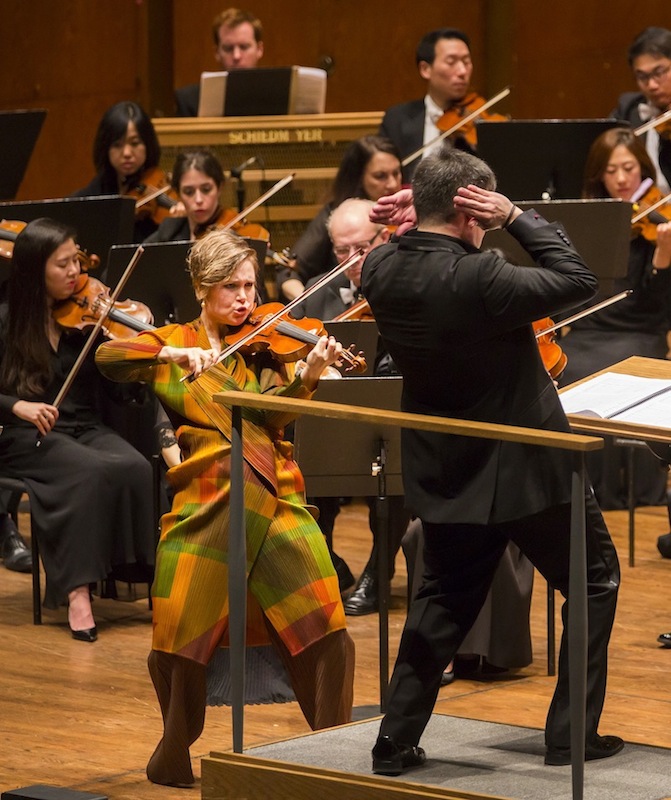Aided by Josefowicz’s fire, Adams returns to form with “Scheherazade.2”

Leila Josefowicz performed the world premiere of John Adams’ “Scheherazade.2” with Alan Gilbert and the New York Philharmonic Thursday night. Photo: Chris Lee.
John Adams has lately seemed in danger of being spoiled by success. The quantity of his recent consistent flow of new work—an enviable run of commissions and performances—has been offset by an inconsistent quality. Excellent, fresh pieces like A Flowering Tree and the String Quartet have been countered by the indifferent The Gospel According to the Other Mary and City Noir, and the truly bad Absolute Jest. His best work furthers his own style, while other pieces have been unsuccessful precisely because they reuse personal tropes and spin out notes to no apparent purpose.
Thursday night’s New York Philharmonic world premiere of Adams’ Scheherazade.2, a Philharmonic co-commission, was a welcome return to form for a composer who, at his best, doesn’t just create satisfying music but extends the classical tradition. The new piece is subtitled “Dramatic Symphony for Violin and Orchestra,” four substantial movements that hew closely to symphonic form, with a featured violin part.
Adams described the piece as a response to the revulsion he felt about the treatment of women in One Thousand and One Nights, and in the contemporary world in general. Modeled somewhat after Belioz, Scheherazade.2 is his story story of a “beautiful, wise young woman” who triumphs over patriarchal persecution. It is a big, sprawling attempt to tell that story.
The four movements introduce Scheherazade and her independent spirit and set her in flight; show her in love; have her face a trial and condemnation; then describe her escape and journey to freedom.
This is a big sprawling piece, an attempt at a grand dramatic narrative that turns the central character of the Arabian Nights into a feminist heroine who rebels against a patriarchal society and finds her freedom. Adams is a storytelling composer, so along with the sheer sound and experience of the music, one listens for how well the story is told.
That part of Scheherazade.2 was problematic at times. Adams channels his story through two devices, the orchestra and soloist Leila Josefowicz, for whom he wrote the piece. Josefowicz is a terrific musician whose playing has an unselfconsciousness that stands out in even when playing clichéd gestures. She digs into portamento, for example, and instead of coming off as sentimental or corny, it sounds hip, and right.
Josefowicz was full of verve and intensity, conveying a heroic stance on stage. The violinist has to be Scheherazade and the soloist was a proud and indomitable presence. That immediately raises the question of whether the piece could work without Josefowicz and her characterization? Could Hilary Hahn play it? Could Gil Shaham? And would it then be an unconventional concerto rather than a proto-feminist musical drama?
The orchestra under Alan Gilbert was less consistent in playing the roles of her various, abstract, antagonists. The first movement—which introduces Scheherazade and has her pursued by “True Believers”—had a tentative, slightly muddled quality. As a first encounter with the work there was no context to discern whether the root was in the composing or the playing. Long stretches of static music turned into a chase that seemed to galvanize the musicians, and the whole performance, with some exciting backward glances at West Side Story.
The second movement, a love scene, has the kind of long, slow, languid string lines that Adams excels in. Josefowicz’s tender solo line offered the only glimpses of Rimsky-Korsakov in the entire piece.
In the third movement, Scheherazade faces a trial, and, after arguments, is condemned. The best music juxtaposes accusatory phrases in the orchestra against the violin’s graceful, implacable arpeggios. But the movement devolved into a mishmash of chatter, and the narrative thread was lost. Stretches like this seemed to be the result of music that was too concerned in following a scenario and lacking internal musical logic and purpose. That undermines the overall, flowing, cinematic landscape that Adams effectively unspools.
The final movement, “Escape, Flight, Sanctuary,” has a series of lush chords that moved through the strings and spelled out the most interesting and satisfying harmonic motion of the piece, especially in the context of what is unusually lean voicing and orchestration from Adams. Josefowicz was at her most vivid here, probing the score’s intellectual and emotional depths. The piece ends with her, playing quietly then fading out on an unresolved harmony, an unexpected and evocatively ambiguous finish.
The concert opened with Alan Gilbert leading a lovely performance of Lyadov’s miniature tone-poem, The Enchanted Lake. The playing was graceful and sensitive, with a wonderfully silky sonority. Instrumental solos emerged like morning mist off the water.
Following this, the Philharmonic played Stravinsky’s original 1911 version of Petrushka. The musicians made the most of the tremendous orchestration, with the entire woodwind section playing with exceptional relish and pianist Eric Huebner brilliant in the concertante part.
The first tableau was bursting with eager energy but perhaps a little tight, expressively. But once Judith LeClair let loose with the solo bassoon whomps, the entire group found a confident swagger that led to a joyous and dramatic performance. The Philharmonic is bringing this piece on their upcoming European tour, and it will undoubtedly leave a lasting impression.